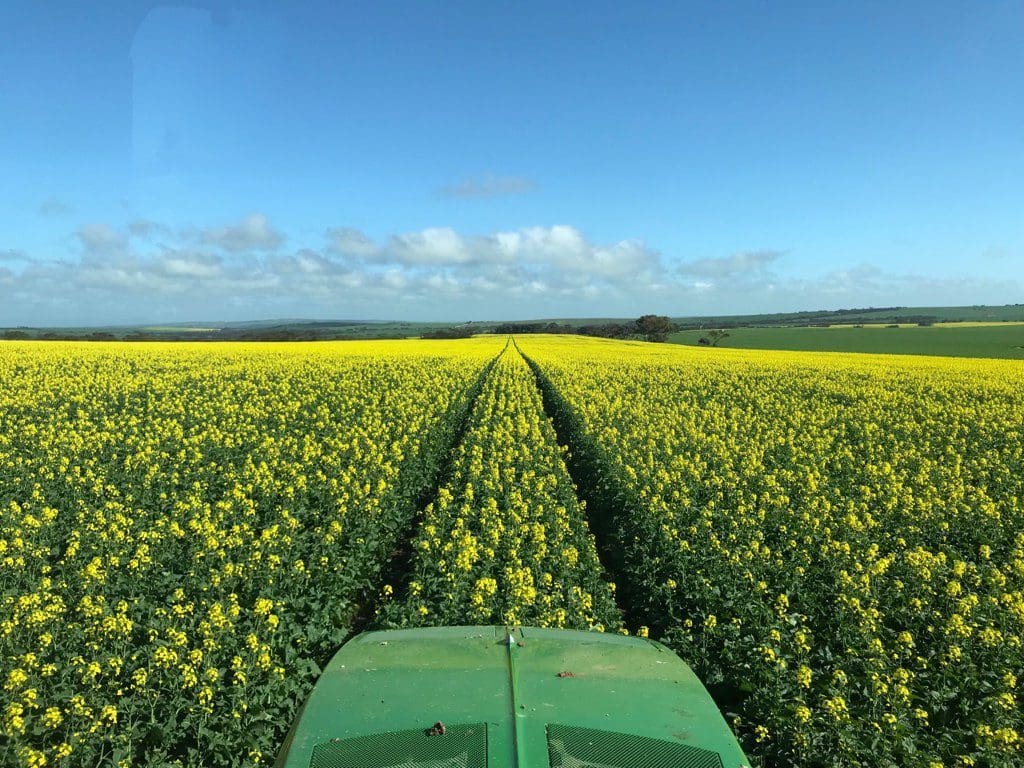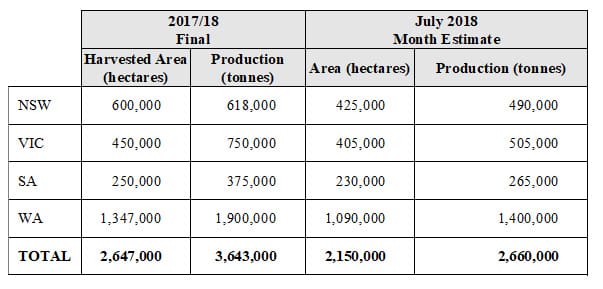
Canola crops like this one at Cockaleechie on South Australia’s lower Eyre Peninsula are among Australia’s best this season.
THE AUSTRALIAN Oilseeds Federation (AOF) has released its initial 2018 forecast for the national canola crop, pegging the area at 2.15 million hectares (Mha), down 14 per cent from the standing ABARES estimate of 2.5Mha.
Production is predicted to be 2.66 million tonnes (Mt), down 27pc on last year’s production.
The AOF draws its estimates from state-based agriculture bodies.
AOF executive officer, Nick Goddard, said the first few months of the 2018 season had been “highly challenging” for canola growers nationally.
“Our estimates at this stage are unlikely to have any upside, with forecast conditions likely to impact the higher yielding areas of New South Wales and Victoria,” Mr Goddard said.
The delayed arrival of planting and germination rains in late May and June got crops in most areas off to an unimpressive start, and a lack of seedbed moisture, combined with warm conditions, has resulted in patchy emergence.
In Western Australia, successive strong winds caused sandblasting and establishment failure in southern and south-central areas, where some paddocks have been resown to barley.
Late sowing, below-average rainfall and severe frosts in mid-July in parts of Victoria and southern and central NSW have delayed growth in most crops.
Mr Goddard said crops were running two or three weeks late in all states, primarily due to late sowing and germination.
“Growers who were able to conserve moisture have a better chance to bring a crop through to harvest, but in many areas, the root system is yet to reach the stored moisture.”
On the upside, the dry season has reduced insect and disease pressure in eastern states.
“Average to above-average rainfall and mild temperatures through August to October will be required to achieve break-even to profitable yields this season, but the rainfall outlook only looks favourable for WA.”

AOF estimates compiled from GIWA, Primary Industries and Resources South Australia, and NSW Department of Primary Industries data.
New South Wales
The NSW canola area is down about 30pc on 2017 sowings, with little reduction in area on the southwest slopes, but a reduction of up to 70pc in districts on the western plains.
Regions most affected by the dry season are the central west, the north, and areas west of the Newell Highway in the south.
Much of the traditional canola zone of southern NSW has recorded only 20-50pc of average autumn rainfall, or 50–120 millimetres of growing-season rainfall to date.
Following slightly below average June rainfall, July has been a dry month, and recent severe frosts have further slowed the crop’s growth.
Falls of 25-50mm are needed for crops to be able to tap into subsoil moisture accumulated from rain in 2017, and yield potential is currently seen as below average, but highly variable, depending on location.
Limited rain in August and September threatens to reduce yield prospects, and grazing or spray-fallowing will be an option for crops with poor yield prospects.
There is currently little biomass for spring haymaking to be considered.
Victoria
Mr Goddard said the Victorian crop was in a similar state to the one in NSW.
“Multiple light rainfalls of 5-10mm through May and early June have led to staggered and patchy establishment in many areas.
“The crop is currently running late for the same reasons as NSW and yield potential is rated as below average.”
With average yield potential, crops in the state’s southwest are seen as having the best yield prospects, while the southern Wimmera has reasonable crops, but little subsoil moisture reserves for spring.
“Other areas such as the Mallee and the north and northeast have patchy crops with a wide range of growth stages — from one to six-to-eight leaf — and crops in the northeast are the poorest in the state.”
South Australia
Following the seasonal break in early May that aided an earlier establishment than Victoria and NSW, conditions have been generally dry since.
The most favourable areas of the state are its southeast, and the Lower Eyre Peninsula, where crops have average yield potential.
Crops in the Upper Eyre Peninsula have very poor yield potential, and are currently suffering moisture stress.
The Mallee is also moisture deficient, and has recently suffered severe frosts, which have significantly impacted growth.
Crops on the Yorke Peninsula and in the Mid-North are described as reasonable, but have no subsoil moisture beneath them, and are in need of rain leading into spring as temperatures begin to rise.
Recent useful rainfall will maintain current potential for only a few weeks.
Western Australia
According to the July 2018 report from the Grain Industry Association of Western Australia (GIWA), WA’s canola area is down about 20pc on last season’s.
Wind damage to young crops in the Midlands, and the Albany and Esperance port zones, may limit their yield potential.
Except for Kwinana West, where crops have average yield potential, subsoil moisture is generally lower than at this time last year.
Most other areas have average to below-average yield potential, and will require at least an average August-October rainfall with mild temperatures.
WA has had much-needed rain of 5-30mm in the past week, and more is forecast, which will bolster yield prospects.
Source: Industry Estimates, GIWA; Primary Industries and Resources South Australia; NSW Department of Primary Industries.
Grain Central: Get our free daily cropping news straight to your inbox – Click here

HAVE YOUR SAY